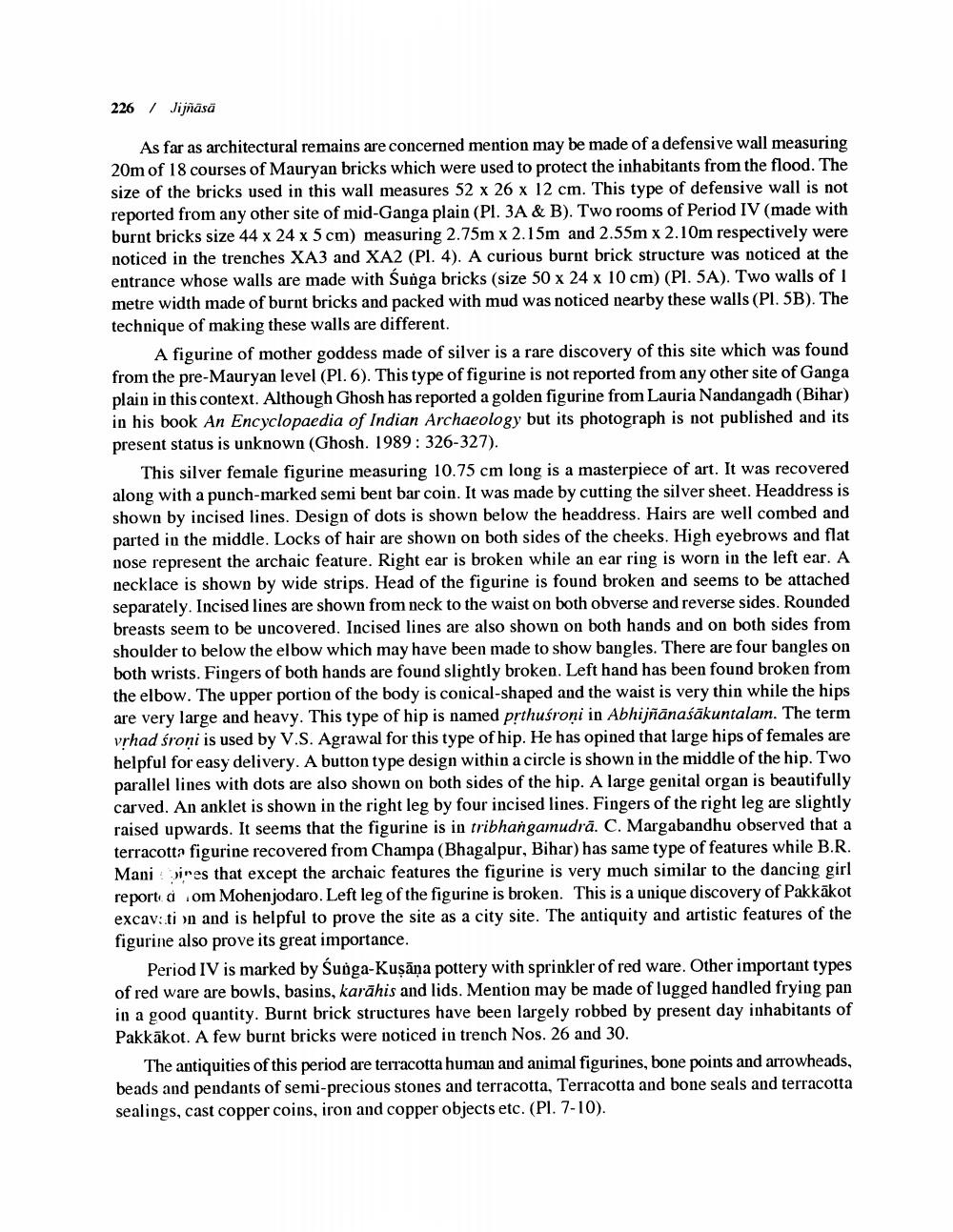________________
226
/
Jijñāsā
As far as architectural remains are concerned mention may be made of a defensive wall measuring 20m of 18 courses of Mauryan bricks which were used to protect the inhabitants from the flood. The size of the bricks used in this wall measures 52 x 26 x 12 cm. This type of defensive wall is not reported from any other site of mid-Ganga plain (Pl. 3A & B). Two rooms of Period IV (made with burnt bricks size 44 x 24 x 5 cm) measuring 2.75m x 2.15m and 2.55m x 2.10m respectively were noticed in the trenches XA3 and XA2 (Pl. 4). A curious burnt brick structure was noticed at the entrance whose walls are made with Sunga bricks (size 50 x 24 x 10 cm) (Pl. 5A). Two walls of I metre width made of burnt bricks and packed with mud was noticed nearby these walls (Pl. 5B). The technique of making these walls are different.
A figurine of mother goddess made of silver is a rare discovery of this site which was found from the pre-Mauryan level (Pl. 6). This type of figurine is not reported from any other site of Ganga plain in this context. Although Ghosh has reported a golden figurine from Lauria Nandangadh (Bihar) in his book An Encyclopaedia of Indian Archaeology but its photograph is not published and its present status is unknown (Ghosh. 1989: 326-327).
This silver female figurine measuring 10.75 cm long is a masterpiece of art. It was recovered along with a punch-marked semi bent bar coin. It was made by cutting the silver sheet. Headdress is shown by incised lines. Design of dots is shown below the headdress. Hairs are well combed and parted in the middle. Locks of hair are shown on both sides of the cheeks. High eyebrows and flat nose represent the archaic feature. Right ear is broken while an ear ring is worn in the left ear. A necklace is shown by wide strips. Head of the figurine is found broken and seems to be attached separately. Incised lines are shown from neck to the waist on both obverse and reverse sides. Rounded breasts seem to be uncovered. Incised lines are also shown on both hands and on both sides from shoulder to below the elbow which may have been made to show bangles. There are four bangles on both wrists. Fingers of both hands are found slightly broken. Left hand has been found broken from the elbow. The upper portion of the body is conical-shaped and the waist is very thin while the hips are very large and heavy. This type of hip is named prthuśroņi in Abhijñānaśākuntalam. The term vrhad śroņi is used by V.S. Agrawal for this type of hip. He has opined that large hips of females are helpful for easy delivery. A button type design within a circle is shown in the middle of the hip. Two parallel lines with dots are also shown on both sides of the hip. A large genital organ is beautifully carved. An anklet is shown in the right leg by four incised lines. Fingers of the right leg are slightly raised upwards. It seems that the figurine is in tribhangamudrā. C. Margabandhu observed that a terracotta figurine recovered from Champa (Bhagalpur, Bihar) has same type of features while B.R. Manipines that except the archaic features the figurine is very much similar to the dancing girl report a om Mohenjodaro. Left leg of the figurine is broken. This is a unique discovery of Pakkākot excav: ti on and is helpful to prove the site as a city site. The antiquity and artistic features of the figurine also prove its great importance.
Period IV is marked by Suðga-Kuşāņa pottery with sprinkler of red ware. Other important types of red ware are bowls, basins, karāhis and lids. Mention may be made of lugged handled frying pan in a good quantity. Burnt brick structures have been largely robbed by present day inhabitants of Pakkākot. A few burnt bricks were noticed in trench Nos. 26 and 30.
The antiquities of this period are terracotta human and animal figurines, bone points and arrowheads, beads and pendants of semi-precious stones and terracotta, Terracotta and bone seals and terracotta sealings, cast copper coins, iron and copper objects etc. (Pl. 7-10).




